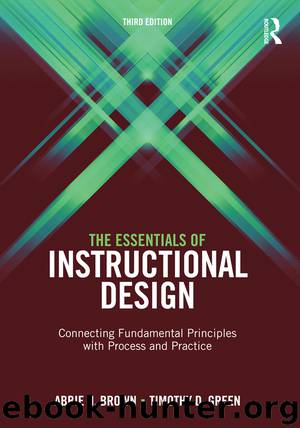The Essentials of Instructional Design: Connecting Fundamental Principles with Process and Practice, Third Edition by Brown Abbie H. Green Timothy D. & Timothy D. Green

Author:Brown, Abbie H.,Green, Timothy D. & Timothy D. Green [Abbie H. Brown]
Language: eng
Format: epub
ISBN: 9781317633143
Publisher: Taylor & Francis Ltd
Distance Education
At present, the most common perception of distance education is that of a traditional classroom experience (one teacher, many students) translated into a communications environment that allows students to participate without having to congregate in a specific geographic location. Distance education may be synchronous (everyone involved participating within a specified time period; using videoconferencing or online chat) or asynchronous (everyone involved participating at a time of his or her own choosing; sharing messages using an online discussion board, postal letters, or email messages). Asynchronous distance education may also be delivered in the form of programmed instruction, allowing the student to review the material at an individualized pace without the need (or support) of a teacher or peer group.
With the ubiquity of inexpensive computing tools and telecommunications and the extensive networking of colleges and universities, internet-based distance education, also known as online learning, has become a particularly popular topic among educators (Brown & Green, 2013, 2014).
In a distance education setting, all instructional activities are delivered through some communications medium that links geographically remote participants. One example is the use of a web-based learning management system (LMS), such as Blackboard or Moodle. A learning management system essentially provides a computer-based empty classroom that an instructor may fill with assignments and presentations; online message boards and chat areas are also a part of the courseware, facilitating communication among participants.
Distance education has a number of appealing features for education and training. Students do not have to travel to a classroom and, in asynchronous situations, they may participate at a time that works best for them. However, there is an interesting opposition of forces at work with distance education. At the same time that more students demand distance education options, most students say they do not really want to learn at a distance—that a live instructor and the presence of learning group peers is important to them (Simonson, Smaldino, Albright, & Zvacek, 2011).
Professionals in Practice
After the initial course consultation and the learning goals are identified, it is time to start chunking out the material by topics. Typically this is done in modules or weeks. Each of those chunks contains all of the learning content/lectures, readings, activities, assessments, and detailed instructions.
Most of my lectures are built with a custom Flash template that uses streaming video and then delivered through a learning management system. I also utilize several rapid development tools. Regardless of the tool(s) that I use to create the media, everything must be 508 compliant and accessible. It is important to remember that not all instructional media components need to be the same. Video is not always necessary or the best medium to deliver the content. Many times voice over PowerPoint or audio alone is just as effective and requires much less development time. In the end, you need to take into account the different platforms the learner may be using (i.e., PC, Mac, and mobile) and provide multiple formats of your media.
Kara Andrew
Manager, Instructional Design
University Extended Education
California State University, Fullerton
Download
This site does not store any files on its server. We only index and link to content provided by other sites. Please contact the content providers to delete copyright contents if any and email us, we'll remove relevant links or contents immediately.
The Art of Coaching Workbook by Elena Aguilar(50990)
Trainspotting by Irvine Welsh(21520)
The Secret History by Donna Tartt(18851)
Twilight of the Idols With the Antichrist and Ecce Homo by Friedrich Nietzsche(18504)
All the Missing Girls by Megan Miranda(15584)
Cat's cradle by Kurt Vonnegut(15189)
Ready Player One by Cline Ernest(14527)
Talking to Strangers by Malcolm Gladwell(13225)
Fangirl by Rainbow Rowell(9098)
The remains of the day by Kazuo Ishiguro(8828)
The Compound Effect by Darren Hardy(8813)
Thirteen Reasons Why by Jay Asher(8799)
Tools of Titans by Timothy Ferriss(8219)
Periodization Training for Sports by Tudor Bompa(8171)
Wonder by R. J. Palacio(8011)
The Lover by Duras Marguerite(7832)
A Court of Wings and Ruin by Sarah J. Maas(7653)
Change Your Questions, Change Your Life by Marilee Adams(7637)
The Complete Stick Figure Physics Tutorials by Allen Sarah(7310)
